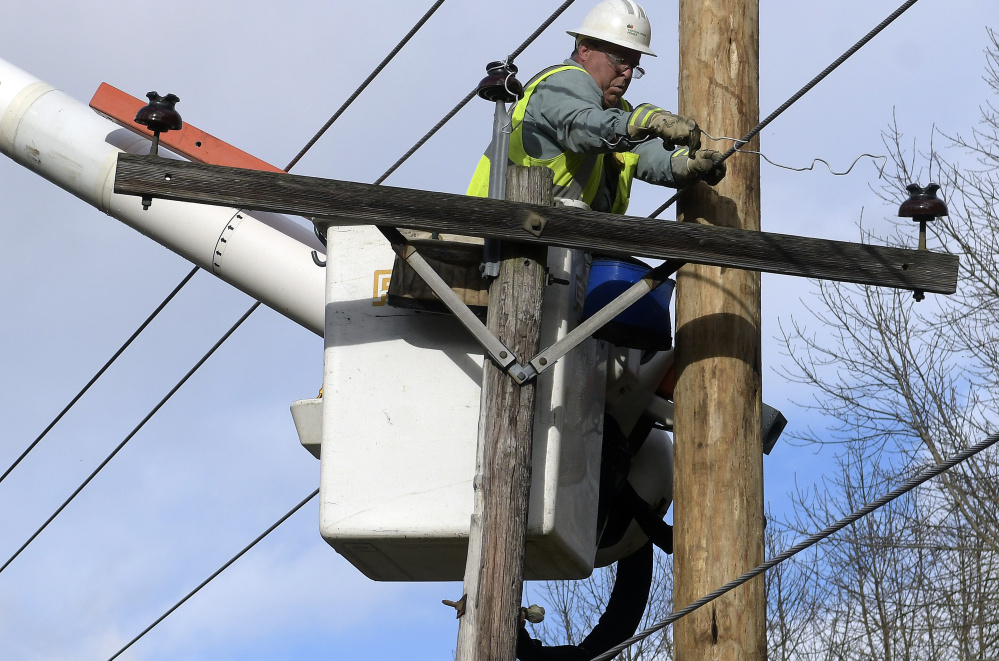AUGUSTA — Molly Jandreau says Monday’s surprisingly severe storm brought back flashbacks of the Ice Storm of 1998 – especially when she lost power and heat in her Glenridge Drive apartment.
Being cold is one thing she remembers all too well about the ice storm. So when she learned Wednesday that an emergency shelter had opened for local residents at the Augusta Civic Center, she and her small dog, Barney, headed for the warmth of the shelter. It was fairly easy because, unlike in January 1998, the streets were not coated in inches of near-impenetrable, treacherously slippery ice.
“In 1998 after the storm, you couldn’t go anywhere. Everything was covered in ice,” Jandreau said Thursday, a day before she planned to drive to Caribou to see her mother and where, she had been assured, there was electricity. “And it was awfully cold.”
Last week’s devastating wind brought Maine nearly a half-million power outages – more than in the Ice Storm of 1998 – but unlike the ice storm, it caused no deaths. Also in contrast to the ice storm, after which some residents lived with no electricity for 23 days, power was expected to be restored to most of the state this weekend.
While those differences are in many ways attributable to differences in the storms themselves, officials believe they learned valuable lessons in the ice storm.
“It has been 20 years since the ice storm, and we’re still making improvements from that storm,” Susan Faloon, public information officer for the Maine Emergency Management Agency, said Friday. “Now we have a new storm to compare all other storms to.”
Six deaths in Maine were attributed to the Ice Storm of 1998. Some died from carbon monoxide poisoning caused by improper operation of generators, including running the gas-powered devices indoors.
Faloon said public outreach efforts meant to teach residents how to use generators safely clearly have helped prevent deaths in this storm.
Sara Burns, president and chief executive officer of Central Maine Power Co., said lessons learned in the ice storm resulted in a more effective response this time.
“This is extraordinary and extensive damage; there is no corner of our service territory that hasn’t been damaged,” Burns said at a MEMA briefing on the storm last week. “Every storm we go into at CMP, we come out having learned something to get better. And we use everything we learn.”
Burns said CMP started planning for the storm prior to its arrival, talking to other utility companies, including in Canada, about sending trucks and workers to help restore power if the help was needed. Last week, hundreds of workers from other utility companies were brought in to help with power restoration.
However, some people said CMP should have prepared more for such storms even well before then, by trimming more trees along power lines ahead of time, to prevent so many trees from falling onto the lines and taking power out.
Pat Colwell, former speaker of the Maine House of Representatives, where he served on the Energy, Utilities and Technology Committee, said in an interview and in a Facebook post that CMP should have been much more aggressive in trimming trees that crowd power lines.
“It seems like 65-mile-per-hour winds should not put a half-million people off the power grid,” said Colwell, a former longtime Gardiner resident who now lives in Bath.
Colwell noted his criticism is not of CMP’s linemen and other workers, who he said are doing a tremendous job restoring power.
Gail Rice, spokeswoman for CMP, said the company adopted a five-year cycle of tree pruning and distribution line inspection and maintenance in 2008, at the direction of the Maine Public Utilities Commission; and since then, tree-related outages have dropped about 30 percent. She said CMP spends about $25 million a year on vegetation management on distribution lines.
Barry Hobbins, the state’s public advocate, said his office and the state Public Utilities Commission have emphasized tree trimming by electrical utilities for the last decade. He said a number of requirements have been imposed on utilities to increase tree trimming, and the utilities have followed those protocols.
Rice said the list of changes made to CMP’s approach to storm recovery since 1998 is too extensive to list, but it includes staging crews and equipment, damage assessment and repair, and arranging for food, lodging and other needs of working crews.
Peter Rogers, acting director of MEMA, said the years of training since the ice storm have greatly improved communications among state, county and local officials.
“This response has been much better, and it’s working very well,” he said. “We’re a resilient state, and we’re used to severe storms, but that doesn’t make them any less devastating.”
Keith Edwards can be contacted at 621-5647 or at:
kedwards@centralmaine.com
Twitter: kedwardskj
Send questions/comments to the editors.




Comments are no longer available on this story